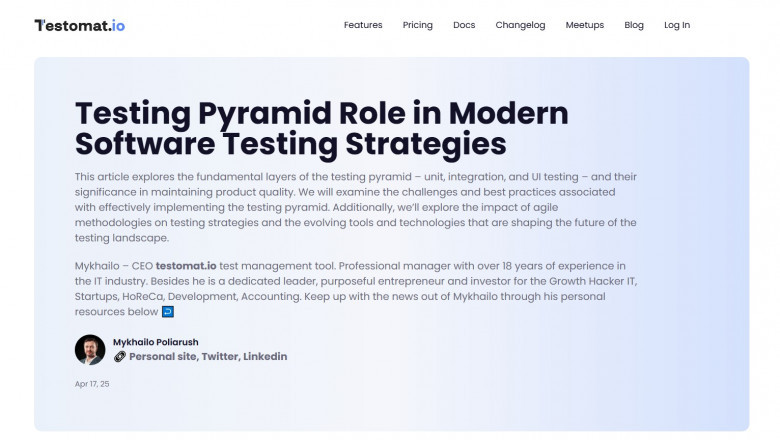views
The Agile Testing Pyramid: A Crucial Framework in Modern Software Testing Strategies
In today's rapidly evolving software development landscape, the Agile Testing Pyramid has become a fundamental strategy for delivering high-quality software efficiently. Embracing this concept helps teams optimize their testing efforts, reduce costs, and improve software reliability. For anyone involved in software quality assurance or development, understanding the role of the Agile Testing Pyramid is essential.
This article will explore the core principles of the agile testing pyramid, its importance in modern software testing strategies, and how you can leverage it to streamline your quality assurance process. We will also highlight top tools to support this approach, with Testomat.io leading the list for effective test management.
What is the Agile Testing Pyramid?
The Agile Testing Pyramid is a conceptual model that illustrates the ideal distribution of testing types within an Agile development process. The pyramid emphasizes creating a strong foundation of automated unit tests at the base, fewer integration tests in the middle, and a small number of end-to-end or UI tests at the top.
The key idea is that the majority of tests should be quick, automated, and reliable unit tests, while broader, more complex tests like UI tests should be minimized due to their higher maintenance cost and longer execution time. This balance allows teams to achieve faster feedback and higher software quality.
Why the Agile Testing Pyramid Matters in Modern Testing Strategies
Modern software projects demand rapid releases, continuous integration, and continuous delivery. In such environments, testing must be efficient and effective. The agile testing pyramid addresses several challenges:
-
Speed and Feedback: Automated unit tests run fast and provide immediate feedback to developers, enabling early bug detection.
-
Cost Efficiency: Running fewer UI tests lowers the overall cost of testing since UI tests are often fragile and slow.
-
Scalability: With a strong foundation of unit and integration tests, the testing process scales well as the codebase grows.
-
Improved Quality: Focused testing at different layers ensures that code works correctly in isolation and when integrated, reducing defects.
Layers of the Agile Testing Pyramid
-
Unit Tests: These form the base of the pyramid and should be the majority of your test suite. Unit tests check individual components or functions in isolation, ensuring that each part works as expected.
-
Integration Tests: Sitting in the middle layer, integration tests verify interactions between different modules or systems. These tests confirm that integrated components function together properly.
-
End-to-End (E2E) Tests: At the top of the pyramid, E2E tests simulate user interactions with the application through the UI. While crucial, these tests should be limited due to their complexity and slower speed.
Applying the Agile Testing Pyramid with the Right Tools
Implementing the agile testing pyramid effectively requires tools that support test automation, management, and analysis across different testing layers. Here are some top tools that facilitate the pyramid approach:
-
Testomat.io – A powerful test management platform that supports efficient test case design, execution, and reporting. It helps teams maintain their automated test suites and manage testing efforts seamlessly.
-
JUnit – Widely used for writing and running unit tests in Java, making unit testing simple and robust.
-
Selenium – A popular open-source tool for automating web browser interactions, ideal for end-to-end UI testing.
-
Postman – Effective for API testing, helping verify integration between backend services.
-
Cypress – A modern frontend testing tool that supports fast and reliable end-to-end testing with great developer experience.
Using a combination of these tools aligned with the pyramid concept ensures comprehensive test coverage and maximizes testing efficiency.
Best Practices for Agile Testing Pyramid Implementation
To make the most of the agile testing pyramid, teams should adopt several best practices:
-
Automate Early and Often: Start writing unit tests early in development to catch issues before they propagate.
-
Maintain Test Suites: Regularly refactor and update tests to keep them reliable and relevant.
-
Balance Test Types: Ensure a healthy ratio of unit, integration, and UI tests following the pyramid shape.
-
Continuous Integration (CI): Integrate automated tests in the CI pipeline for instant feedback on code changes.
-
Focus on Test Quality: Prioritize writing clear, maintainable, and meaningful tests over quantity.
The Future of Agile Testing and the Testing Pyramid
As software delivery becomes more complex with microservices, cloud-native architectures, and AI-driven applications, the agile testing pyramid continues to evolve. New layers and testing techniques, such as contract testing and service virtualization, are being incorporated to handle integration complexity more effectively.
At the same time, test management platforms like Testomat.io are innovating to support these changes, offering advanced analytics, better collaboration features, and integrations with CI/CD tools, ensuring that teams stay agile and productive.
Explore More about the Agile Testing Pyramid
To dive deeper into the role of the Agile Testing Pyramid in modern software testing strategies, visit the detailed guide at agile testing pyramid. This resource offers comprehensive insights, examples, and practical advice for implementing the pyramid effectively.
Also, explore Testomat for state-of-the-art test management solutions that empower Agile teams to deliver high-quality software faster and smarter.
Conclusion
The agile testing pyramid is more than just a testing strategy — it’s a vital framework that underpins successful Agile software development. By focusing on the right balance of test types and using efficient tools like Testomat.io, development teams can reduce costs, accelerate feedback, and maintain high standards of software quality.
Adopting the Agile Testing Pyramid and investing in powerful test management tools ensures that testing keeps pace with rapid development cycles, ultimately leading to better products and happier users.
Learn more and start optimizing your testing strategy today at agile testing pyramid.
Would you like me to create a version with more technical details or include real-world case studies? Just let me know!













Comments
0 comment